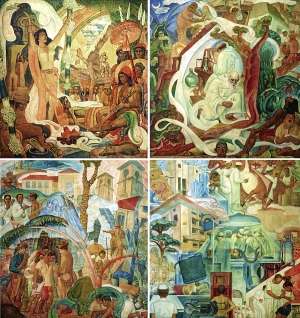The Progress of Medicine in the Philippines
The Progress of Medicine in the Philippines is a painting by Filipino artist Botong Francisco. It was commissioned in 1953 to depict the history of Philippine medicine. It is currently on display in the National Museum of Fine Arts in Manila.[1]
| The Progress of Medicine in the Philippines | |
|---|---|
 | |
| Artist | Botong Francisco |
| Year | 1953 |
| Medium | Oil |
| Dimensions | 2.92 m × 2.76 m (9.6 ft × 9.1 ft) |
| Location | National Museum of Fine Arts, Manila |
The painting
In 1953, Dr. Agerico Sison, then director of Philippine General Hospital, and Dr. Eduardo Quisumbing, director of the National Museum, Dr. Florentino Herrera Jr., and Dr. Constantino Manahan commissioned Botong Francisco to create a painting depicting the history of Philippine medicine.[2]
The painting consists of four oil-on-canvas panels depicting medical practice in the Philippines in four historical eras. They were displayed at the lobby of the Philippine General Hospital for 58 years until their permanent relocation to the Museum Foundation of the Philippines Hall at the National Museum of the Philippines on 27 July 2011.
Restorations
Tomas Bernardo restored the panels in 1974 and 1991. Its 2006 restoration was under Orlando Abinion’s supervision and was funded by the US Department of State’s Ambassadors Fund for Cultural Preservation. Abinion's team worked on the restoration in 2006 and 2007, with conservation treatment activities including solubility testing, facing and consolidation of paint layers, cleaning of surfaces and removal of old lining and re-lining, removal of facing, surface dirt and old varnish, grafting of holes and leveling lacunae, and preliminary and final retouching.[3]
The restored works are on indefinite loan from the University of the Philippines, PGH’s principal, and are on permanent exhibit in the National Museum of Fine Arts.
In exchange, the museum hung two reproductions created by photographer Benigno T. Tod III of the same size on the two sides of the PGH lobby.
Cultural significance
On 21 September 2011, the four-panel painting was declared a national treasure for being an “irreplaceable part of the institutional heritage of the Philippine General Hospital and the University of the Philippines, and of the cultural heritage of the nation."[4]
References
- Sedfrey, J. (12 January 2012). "In Focus: Making Botonga's masterpieces accessible". Republic of the Philippines, Office of the President. Retrieved 6 May 2018.
- Orendain, Joan. "National Museum unveils restored 'Botong' murals this week". inquirer.net.
- "Restoration of Four Murals by Philippine National Artist Carlos Francisco at the Philippine General Hospital in Manila | U.S. Embassy in the Philippines". U.S. Embassy in the Philippines. 2 January 2006. Retrieved 7 May 2018.

- "Botong Francisco's paintings at PGH find new home". gmanetwork.com.
External links
- Carlos V. Francisco's The Progress of Medicine in the Philippines: Renegotiating decisions and collaborations in conservation Carlos V. Francisco's The Progress of Medicine in the Philippines: Renegotiating decisions and collaborations in conservation
- "The Progress of Medicine in the Philippines" by Carlos V. Francisco (slideshow), photos courtesy of the National Museum of the Philippines, GMA News online